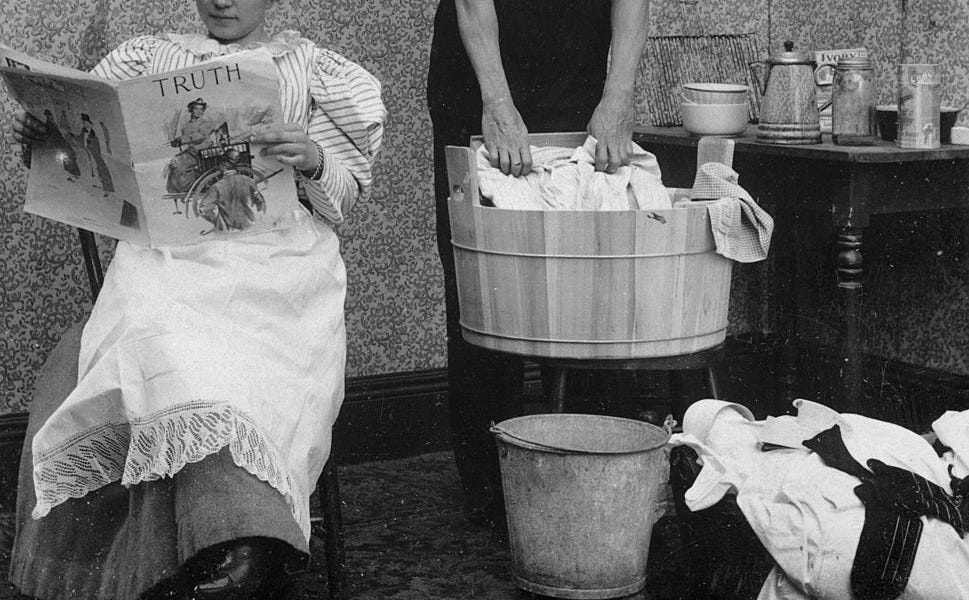Addressing Gendered Norms in Unpaid Labor
المفاهيم الأساسية
The author delves into the persistence of gendered norms around unpaid labor, highlighting the root cause of burnout and relationship resentment. The book emphasizes the importance of modeling equitable distribution of labor for future generations.
الملخص
The content explores the frustration surrounding unequal distribution of unpaid labor in relationships, despite beliefs in feminism. It discusses the impact on individuals' well-being and relationship dynamics, emphasizing the need for change. The author introduces the concept of Equal Partnerships and provides practical methods to combat gendered divisions in household labor. Additionally, insights from interviews with diverse men who are Equal Partners shed light on the benefits and challenges of striving for parity. The narrative encourages small conversations and practices as access points to initiate change towards more equal partnerships at all levels of society.
إعادة الكتابة بالذكاء الاصطناعي
إنشاء خريطة ذهنية
من محتوى المصدر
زيارة المصدر
annehelen.substack.com
What to Actually Do About an Unequal Partnership
الإحصائيات
"the division of labor in the home has settled at around 65% performed by women and 35% performed by men."
"household gender dynamics have not changed much since the mid 80’s."
اقتباسات
"Time and flexibility are incredibly valuable resources. With more time and flexibility, the person doing male-coded work has a whole menu of opportunities."
"Noticing is one of those deep values that is hard to get to because it is buried under so many layers of gender norms."
استفسارات أعمق
What societal factors contribute to resistance against changing unequal divisions of labor?
The resistance against changing unequal divisions of labor is influenced by various societal factors deeply rooted in gender norms and expectations. One significant factor is the historical construction of gender roles, where women have been traditionally assigned tasks related to caregiving, household chores, and emotional labor, while men have been associated with breadwinning and outdoor maintenance tasks. These ingrained stereotypes create a sense of normalcy around unequal divisions of labor.
Moreover, the lack of policy support for work-life balance and caregiving responsibilities further reinforces these gendered norms. In many societies, there is limited access to affordable childcare services or paid parental leave, which often results in one partner (usually the woman) taking on more unpaid labor at home. This lack of structural support makes it challenging for couples to achieve equality in their division of labor.
Additionally, socialization plays a crucial role in perpetuating these inequalities. From a young age, individuals are exposed to gendered expectations through media representations, family dynamics, and educational systems. These early influences shape beliefs about what constitutes "appropriate" behavior for each gender within relationships.
Furthermore, the reinforcement of traditional gender roles within communities can also contribute to resistance against change. Peer pressure and societal expectations may discourage individuals from deviating from established norms regarding household responsibilities.
How can reframing tactics like "the bossy wife decoy" perpetuate traditional gender roles?
Reframing tactics such as the "bossy wife decoy" serve as strategies employed by individuals or couples to justify unequal divisions of labor based on traditional gender roles. By portraying one partner (often the woman) as assertive or dominant in decision-making processes within the relationship while downplaying her actual workload at home compared to her partner's contributions outside the house (male-coded tasks), this tactic reinforces stereotypical notions about women's roles being centered around managing domestic affairs rather than sharing equal responsibility with their partners.
The use of such reframing tactics not only masks underlying inequalities but also shifts focus away from addressing systemic issues related to unpaid care work and cognitive load carried primarily by women in households. By creating an illusion that power dynamics are reversed when they are not truly equitable behind closed doors, these tactics maintain status quo arrangements where women continue shouldering a disproportionate burden without receiving proper recognition or support for their efforts.
Moreover, employing labels like "bossy wife" contributes to negative stereotypes about assertive women who take charge or express preferences within relationships. It reinforces harmful narratives that undermine female authority and agency while reinforcing male dominance in decision-making processes both inside and outside the home.
How can everyday conversations serve as entry points for promoting more equal partnerships?
Everyday conversations present valuable opportunities for initiating discussions around promoting more equal partnerships by challenging existing gender norms and fostering awareness about shared responsibilities within relationships.
One effective approach during these conversations is acknowledging subtle instances where traditional stereotypes manifest themselves—such as assumptions about certain tasks being inherently tied to specific genders—and gently questioning those beliefs without confrontation.
By expressing personal perspectives on topics related to household duties or caregiving responsibilities grounded in principles of equity rather than conformity with outdated norms,
individuals can plant seeds for reflection among peers or family members.
These dialogues help normalize alternative viewpoints that prioritize fairness,
mutual respect,
and collaboration between partners
while highlighting how small changes
in attitudes
and behaviors can collectively lead
to significant shifts towards greater equality at home.
Encouraging open communication,
active listening,
and empathy during everyday interactions creates safe spaces
for exploring new ideas
and redefining relationship dynamics based on shared values rather than preconceived notions dictated by society’s expectations.
Ultimately,
these entry points pave way for ongoing discussions
that foster deeper understanding,
empathetic connections between partners,
and collective efforts towards building more balanced partnerships founded on mutual appreciation
and cooperation

